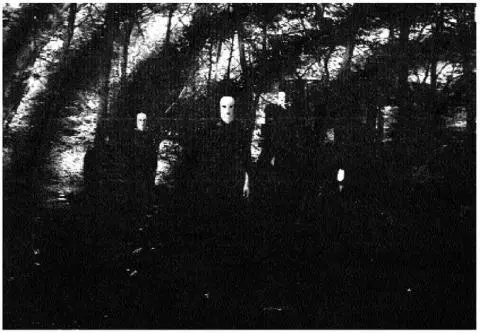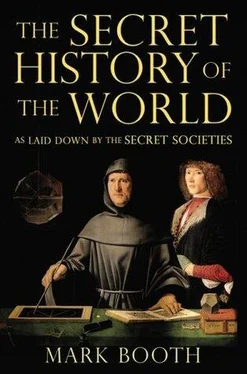At this turning point in history people began to feel insecure on a level that today we call the existential. They were less sure that they lived in a cosmos that was ultimately benevolent, where everything would turn out right in the end. They began to suffer for the first time the species of fear that Emile Durkheim named anomie — fear of the destructive chaos that creeps in at the margins of life, that may attack us from the darkness outside the encampment or from the darkness that overwhelms us when we are sleeping. It may also lie in wait for us when we are dead.
WHEN WE FALL ASLEEP WE LOSE ANIMAL consciousness. In the teachings of the secret societies animal consciousness — or spirit — is pictured floating out of the body in sleep. This has two main consequences. First, without the animal element our body returns to a vegetating state. No longer sapped by the agitations of animal consciousness or the wearying effect of thought, the bodily functions that the vegetable element controls are renewed. We wake up refreshed.
Second, detached from the sensory perceptions of the body, the spirit enters an alternative state of consciousness, which is an experience of the sub-lunary spirit world. In dreams we perceive the spirit worlds, where we are approached by angels and demons and the spirits of the dead.
Or at least that is what humans experienced in the time of the Rishis. By the time of Zarathustra human nature had become enmeshed in matter and so corrupted that dreams had become chaotic and difficult to interpret. They were fantastical now and full of strange, distorted meanings. Still, dreams might contain promptings by spirits, fragments of past lives, even memories of episodes from history.
In deepest sleep the Third Eye may open and peer into the spirit worlds, but on waking we forget.
AFTER YEARS IN EXILE, THE YOUNG ZARATHUSTRA felt the need to return to Iran. On the border he had a vision. A gigantic shining creature of spirit came to meet him and told him to follow. Zarathustra had to take ninety steps to the spirit’s gigantic nine as the spirit swept over the stony ground, taking Zarathustra to a clearing, hidden by rocks and trees. There a circle of six other, similar spirits hovered above the ground. This shining company turned to welcome Zarathustra, and invited him to leave his physical body for a while in order to join them.

Marble group of the second century BC. Mithras, archangel of the sun — St Michael in Hebrew tradition — is here slaying the cosmic bull of material creation. From the bull’s spine sprouts the corn of vegetable life and from his blood the wine of animal life. Note that Mithras is wearing the ‘Phrygian cap’ which resurfaced into exoteric history when it was worn by initiates of the secret societies who led the French Revolution. The French Martinist Joseph de Maistre wove together from various sources an account of the Mithraic initiation ceremonies. A pit was dug, which the candidate stood in. A metal grille was placed over the opening to the pit, and on this stood a bull that was sacrificed. The candidate would become drenched by the blood of the bull raining down from above. In another part of the ceremony the candidate would lie in a tomb as if dead. Then the initiator would grasp him by the right hand and pull him up into ‘new life’. There were seven grades of initiate: Raven, Nymphus, Soldier, Lion, Persian, Courier of the Sun and Father.
We have met these shining spirits before. They are the spirits of the sun called in Genesis the Elohim. They now prepared Zarathustra for his mission.
First, they told him he must pass through fire without being burned.
Second, they poured molten lead — the metal of Ahriman — on to his chest, which he suffered in silence. Zarathustra then took the lead from his chest and calmly gave it back to them.
Third, they opened up his torso and showed him the secrets of his inner organs, before closing him up again.
Zarathustra returned to court and preached what the great spirits had revealed. He told the king that the sun spirits who created the world were working to transform it, and that one day the world would be a vast body of light.
The king he was addressing was a new one, but, like his predecessor he was in thrall to evil ministers. He did not want to hear this good news and let his ministers persuade him to have Zarathustra thrown in prison.
But Zarathustra escaped from prison and also from attempts to murder him. He lived to fight many battles against the forces of evil, battles where he pitched his magic powers against the powers of evil sorcerers. Later he became the archetype of the wizard, with a tall hat, cloak of stars and an eagle on his shoulder. Zarathustra was a dangerous, somewhat disconcerting figure, prepared to fight fire with fire.
He led his followers to secluded grottoes, hidden in the forests. There in underground caverns he initiated them. He wanted to provide them with the supernatural powers needed to fight the good fight. We know about this early Mystery school, because it survived five millennia underground in Persia before resurfacing as Mithraism, an initiatory cult popular among Roman soldiers, and then again in Manichaeism, a late Mystery religion which included St Augustine among its initiates.
Zarathustra prepared his followers to face Ahriman’s demons or Asuras by terrifying initiation ordeals. He who fears death, he said, is already dead.
It was recorded by Menippus, the Greek philosopher of the third century BC, who had been initiated by the Mithraic successors of Zarathustra, that, after a period of fasting, mortification and mental exercises performed in solitude, the candidate would be forced to swim across water, pass through fire and ice. He would be cast into a snake pit, and cut across the chest by a sword so that blood would flow.
By experiencing the outer limits of fear, the initiate was prepared for the worst that could happen, both in life and after death .
An important part of this preparation was inducing in the candidate conscious experience of the separation of the animal part of his make-up from the vegetable and material parts, as happens in sleep. Equally important was to experience the separation of the animal from the vegetable part, as happens after death. In other words initiation involved what we today sometimes call an ‘after-death experience’.

Paracelsus said: ‘It is as necessary to learn evil things as good, for who can know what is good without learning what is evil.’ Meeting of a contemporary secret society in woods in West Sussex, England. It is sometimes supposed that all secret societies engage in commerce with evil spirits. However, the great, historically significant secret societies, such as the Rosicrucians and the Freemasons, acknowledge the dark side in order to combat it.
By the act of leaving the body the candidate knew beyond any possibility of doubt that death was not the end.
People who learn how to dream consciously , that is to say with the ability to think and exercise willpower we normally only enjoy in waking life, may develop powers which are ‘supernatural’ by today’s definitions. If you can dream consciously, then you are on the way to being able to move about the spirit worlds at will, communicating freely with the spirits of the dead and other disembodied beings. You may perhaps learn about the future in ways which might otherwise be blocked. You may be able to travel to other parts of the material universe and view things where you are not bodily present — so-called astral travel. The great sixteenth-century initiate Paracelsus, who, as we shall see, has some claims to be the father of both modern experimental medicine and homeopathy, said he was able to visit other people in their dreams .
Читать дальше














